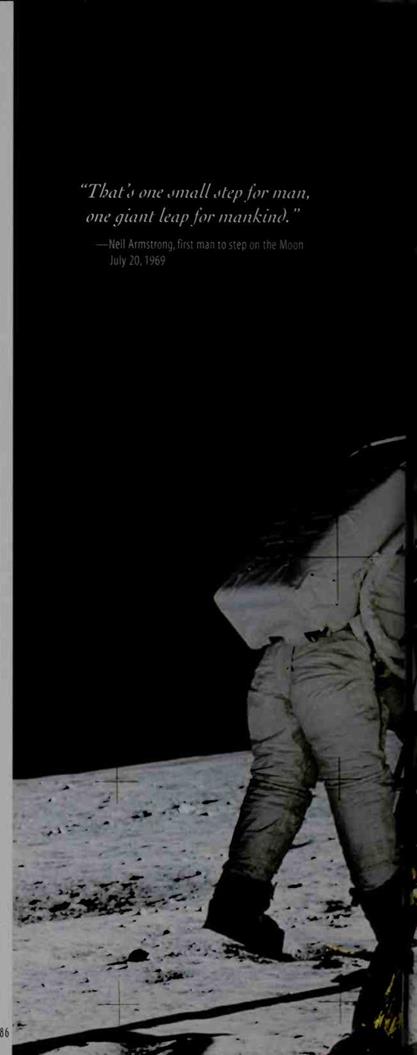One Small Step
ON July 19, 1969, Apollo 11 reached lunar orbit. The next day Alichael Collins piloted Columbia in I orbit around the Aloon as the other two! astronauts crawled into the lunar module Eagle. Neil Armstrong fired Eagle’s descent engine.
Th en he gently landed Eagle s spiderlike legs on the Moon’s surface. In words broadcast to parth, he announced to. Mission Control in I Iouston. Texas: "The Eagle has landed.”
Dressed in a space suit, Armstrong opened Eagle’s hatch and stepped down onto the Aloon. The first human to explore a new world, he described his step as a "giant leap for mankind.” Buzz Aldrin soon followed. A TV camera showed the amazing event to viewers on Earth. The two astronauts spent 2 hours on the Aloon s surface. They planted an American flag, collected Moon rocks, took photographs and scientific measurements, and received a telephone call from President Richard Nixon. Finally, they returned to the Eagle. Alter 21 hours and 36 minutes on the Aloon, they lifted off to dock with Columbia for the journey home.
< Greetings From Earth
During their historic visit to the Moon, Apollo 11 astronauts left this aluminum plaque behind. Its message of peace was signed by all three astronauts and by • U. S. President Richard M. Nixon.
► Moon Visitor
The second man on the Moon, astronaut Buzz Aldrin climbs down the ladder of the lunar module Eagle to the lunar surface. He and astronaut Neil Armstrong explored the Moon’s surface and collected lunar rock and soil samples.
Fun Fact: Feeling Light
 The Moon’s gravity is one-sixth that of Earth’s. This allowed the astronauts on the Moon to jump high easily. If you jumped lightly on the Moon, it would feel like bouncing on a trampoline.
The Moon’s gravity is one-sixth that of Earth’s. This allowed the astronauts on the Moon to jump high easily. If you jumped lightly on the Moon, it would feel like bouncing on a trampoline.

 |
Apollo ii Crew
Astronauts of Apollo 11 made the first successful landing on the Moon. From left: Neil Armstrong, flight commander, Michael Collins, pilot of the command module Columbia, and Edwin "Buzz" Aldrin, Jr., co-pilot of the lunar module Eagle.
У Splashdown
After reentering Earth’s atmosphere, protected from the fiery heat by their spacecraft’s heat shield, the astronauts splashed down in the Pacific Ocean. Navy divers arrived by helicopter to rescue them.
![]() FTER Apollo 11, five more Apollo missions landed on the Moon. The last three missions brought along a special car, called the Lunar Roving Vehicle. Known as the Lunar Rover, or "Moon buggy,” this battery-powered car helped the astronauts drive for miles over ihe Moon to collect rock and soil samples and explore its dusty surface.
FTER Apollo 11, five more Apollo missions landed on the Moon. The last three missions brought along a special car, called the Lunar Roving Vehicle. Known as the Lunar Rover, or "Moon buggy,” this battery-powered car helped the astronauts drive for miles over ihe Moon to collect rock and soil samples and explore its dusty surface.
The Rover had a TV camera so people on Earth could see what the astronauts saw. Viewers discovered an amazing variety of terrain, including lunar plains, canyons, anti craters.
The astronauts worked outside for several hours a day, exploring, doing scientific experiments, and collecting samples.
All together, the Apollo astronauts collected 855 pounds of rock in many dillerent sizes. One discovery was a rock found to be over four billions years old. Called the "genesis rock, ” it was thought to be part of the Moon’s original crust. Such geological clues helped scientists unlock many secrets ol the Moon’s past.
т Lunar Rover
 |
 The Lunar Rover was made of lightweight metal, mainly aluminum. It hail wire mesh tires to grip the dusty lunar surface. The battery- powered car had a TV camera, umbrella-shaped antenna, and tool rack. lt could travel 7 miles an hour. In it, the astronauts explored many miles from base.
The Lunar Rover was made of lightweight metal, mainly aluminum. It hail wire mesh tires to grip the dusty lunar surface. The battery- powered car had a TV camera, umbrella-shaped antenna, and tool rack. lt could travel 7 miles an hour. In it, the astronauts explored many miles from base.

 |
|
|

|
|
OLLO 17 was the last mission to visit the Moon. At the end of the mission in 1972, the astronauts left behind a plaque. It signaled the end of the human Moon explorations. When the astronauts climbed into their lunar module and left lor home, they had completed a great adventure and an important job.


 A total ol 12 men landed on the Moon. They gathered a vast store of knowledge. From rock and soil samples, scientists learned about the Moon’s formation, history, and chemistry. They discovered that iMoon minerals are similar to Earth’s but many have heavier iron and titanium content. They found the Moon has a very thin atmosphere of helium, hydrogen, argon, and neon. They also found that the Moon has a magnetic. field.
A total ol 12 men landed on the Moon. They gathered a vast store of knowledge. From rock and soil samples, scientists learned about the Moon’s formation, history, and chemistry. They discovered that iMoon minerals are similar to Earth’s but many have heavier iron and titanium content. They found the Moon has a very thin atmosphere of helium, hydrogen, argon, and neon. They also found that the Moon has a magnetic. field.
Considered one of the greatest scientific achievements of human history, Apollo established the United States as the world leader in space technology. It also began an exciting new era of exploring the frontiers of space.


 Fun Fact: Long Way From Home
Fun Fact: Long Way From Home
The Moon’s distance from Earth is about
239,0 miles. Apollo 11 took a total of four days to get to the Moon, traveling at speeds of up to 24,182 miles an hour.
|
|












